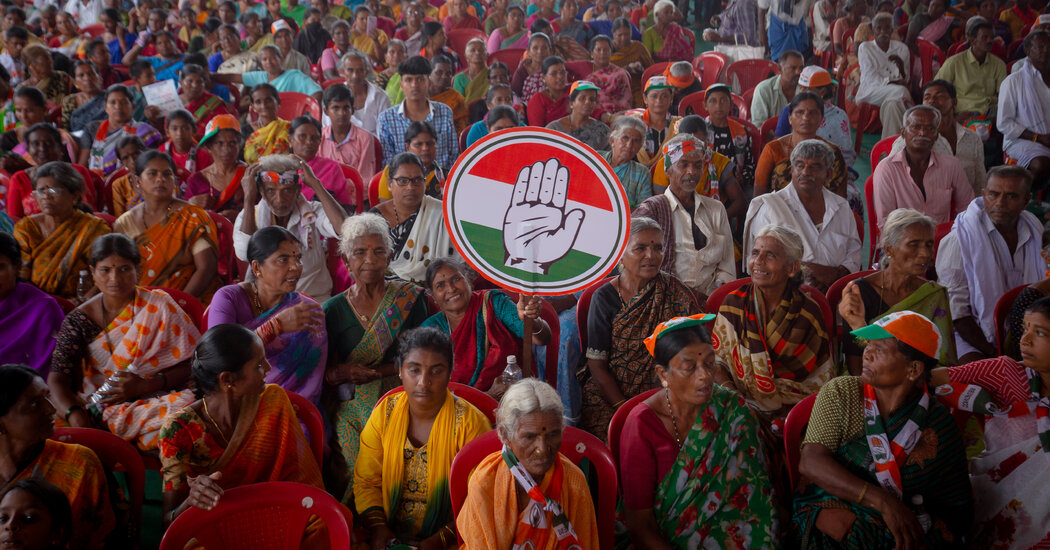
The last time Indians voted in a national election, in 2019, the Bharatiya Janata Party, led by Prime Minister Narendra Modi, won running away. But even then, more than 60 percent of voters cast ballots for other parties.
That Mr. Modi has established such dominance in Parliament despite falling well short of majority popular support is a reflection of a dysfunctional and fractured political opposition.
The main opposition party, the Indian National Congress, governed for decades after the country’s independence in 1947, guided by the Nehru-Gandhi dynasty. The party’s standing is now much reduced: In 2019, it won 52 seats in Parliament to the B.J.P.’s 303. It is not expected to do much better in this year’s election, which began on Friday and runs for six weeks.
Here’s why India’s political opposition is in such dire straits.
The Congress is a shell of what it once was.
The Congress, long positioned at India’s political center, has struggled to find a direction and offer an ideological alternative to the Hindu nationalist B.J.P. That has held back the broader opposition’s fight against Mr. Modi.
The Congress has faced a leadership crisis, a series of rebellions and bouts of infighting. Even after two consecutive losses to Mr. Modi, the party has stuck to its dynastic leadership. It has again put forward Rahul Gandhi, the son, grandson and great-grandson of Indian prime ministers, as its face in taking on Mr. Modi.
Mr. Gandhi has tried to increase his political weight by leading long marches across the country, including one of more than 2,000 miles. But when he has seemed to find momentum, the B.J.P. has moved to check it.
After his first march, which drew large crowds, the B.J.P. ensnared him in a court case that led to his expulsion from Parliament. He was later returned to his seat by India’s highest court.
His party’s losses in a couple of important state elections in recent months also threw it off course, laying bare the extent of its deeply entrenched problems.
A coalition of parties has trouble uniting.
In the months before the election, a range of opposition parties formed an alliance catchily named INDIA, short for the less mellifluous Indian National Developmental Inclusive Alliance.
The coalition’s creation caused unease among B.J.P. leaders, suggesting that the election could be a less one-sided affair.
But a series of bitter disagreements over the sharing of seats among alliance members has disappointed many supporters. In some states, parties in the coalition failed to iron out longstanding differences, putting the protection of local turf over the national ambition of challenging Mr. Modi.
One state’s chief minister, who was a founder and prominent face of the opposition bloc, even switched sides to join the B.J.P. Mr. Modi has been relentless in trying to split the coalition, luring some members with incentives and bogging down others with investigations and jail sentences.
Modi uses the government to go after opponents.
Opposition groups say Mr. Modi is having government agencies do his political work for him. They seem to have good reason: Opposition leaders have been the target of about 90 percent of the cases involving politicians pursued by the country’s top financial crimes agency since Mr. Modi took power in 2014.
Weeks before this year’s election, tax agencies under Mr. Modi moved to freeze the Congress’s bank accounts, leaving the party paralyzed. The Modi government has also sent two chief ministers from opposition parties to jail.
While the Congress has long been the subject of Mr. Modi’s wrath — he has even declared that he wants a “Congress-free India” — a smaller outfit, the Aam Aadmi Party, or A.A.P., has faced a particularly harsh crackdown.
Mr. Modi, analysts say, sees the A.A.P. as a potential national challenger as the Congress fades. The party runs the governments in the Delhi capital region and in the state of Punjab, and has made inroads in Mr. Modi’s home state of Gujarat.
Opposition attack lines find limited traction.
The opposition coalition has gone after Mr. Modi largely on two issues: the increasing authoritarianism it says is turning India’s democracy into one-party rule, and political corruption it contends is enriching a small elite.
Opposition leaders have also pointed to growing inequality and India’s huge shortfall in jobs, particularly for its massive population of young people.
It’s unclear whether these lines of attack have done much to dent Mr. Modi’s standing. He has amassed great power and popularity through a potent mix of Hindu majoritarianism, robust welfare programs and his own personal charisma.
Mr. Modi also has enormous control over India’s channels of information, with the broadcast media particularly bent to his wishes.
Mujib Mashal contributed reporting.
Discover more from reviewer4you.com
Subscribe to get the latest posts to your email.




